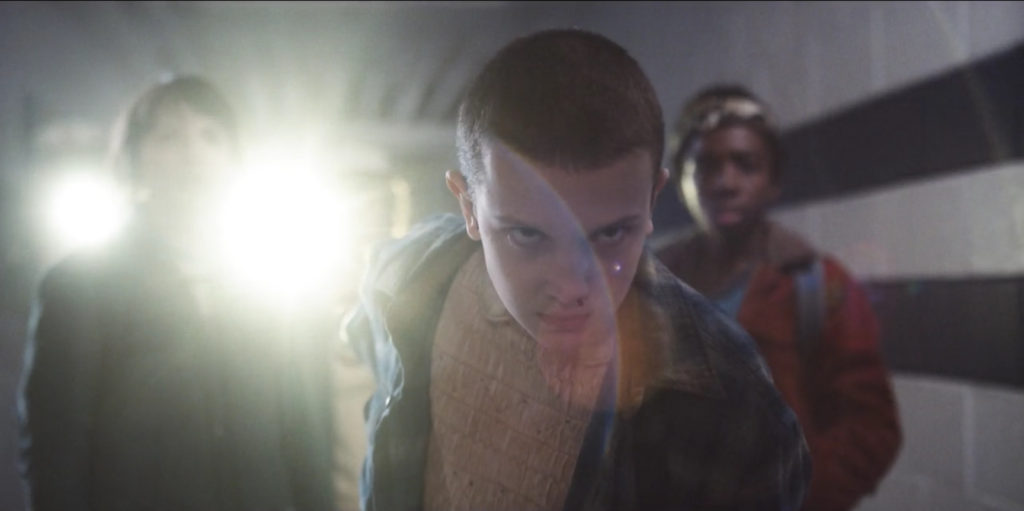Nostalgia is a powerful thing — especially in film and TV. When done correctly, viewers will often rejoice at what filmmakers ”got right” and bemoan what feels inauthentic. Of course, what we’re celebrating or bemoaning is a style of filmmaking (or TV production) back in the day — not really the routine of the daily lived experience of most people. With ”Stranger Things” that premiered on Netflix on July 15th, Matt and Ross Duffer (aka ”The Duffer Brothers” who were born in 1984) have gone back in time to 1983 to tell a story of monsters, Cold War experiments, tween misfits, and supernatural mysteries all taking place in Hawkins, Indiana. With more than a nod to the filmmaking and story styles of Steven Speilberg, Stephen King, John Carpenter, and even George Lucas (Star Wars references abound), The Duffer Brothers take us on an eight episode romp through the early 80s before ”The 80s” became associated with New Wave, hair metal, and hip-hop. The year 1983 was in many ways still the 70s for much of suburban and rural United States, and the style of clothing, the music that was listened to, and even the cultural touchstones, were very much rooted in the previous decade. And what The Duffer Brothers get right about their recreation of 1983 is how the dispersion of newer cultural and fashion trends from urban centers hadn’t reached Main Street yet.
However, ”Stranger Things” isn’t only about nostalgia, It’s about telling a compelling story. And while The Duffer Brothers do tell a compelling tale, there’s something missing from the overall story. The narrative itself is pretty cookie cutter when it comes to drama that hooks viewers: missing children. In the case of ”Stranger Things” the missing child is 12-year-old Will Byers who gets abducted by some…thing while riding his bike home one evening after playing a marathon session of Dungeons & Dragons with his friends, Lucas, Dustin and Mike. Will’s mother, played by a frantic Winona Ryder, drops everything (including her job as a clerk at a local home and goods shop) to look for her kid with her older misfit son, Jonathan. The search loops in local law enforcement — and with it an alcoholic police chief, Jim Hopper. At one point, the whole town is looking for Will, but matters get complicated with the arrival of a girl known as ”11″ — who has telekinetic abilities (like Carrie White did in the movie and book, ”Carrie”). Lucas, Mike and Will, befriend 11 and take her (a la E.T.) to Lucas’ home where they try and figure out where she came from. Lucas and 11 (or ”El”) form a bond of friendship, and the boys soon find out that El has the ability to not only contact Will in another realm called ”the upside down” — where he’s being held captive by some kind of creature that feasts on humans and animals — but she reveals that she’s been part of some kind of Cold War experiment where her telekinetic abilities are being fashioned into a weapon.
So see? There’s some very good elements going into the story. The pace of the drama unfolds well, but a few things bothered me on the way to the ending. First was the acting. Now Winona Ryder can turn in a good performance when directed correctly, but in ”Stranger Things” her performance tends to hit only one note (i.e., that of a frantic mother). A more skilled director would be able to pull her back at times (and push her toward more intensity) in order to give her acting more variation — but that wasn’t the case here. Matthew Modine, as Dr. Brenner, is mostly one-dimensional throughout the series, and, at one point, it was kind of comical to watch him wearing a hazmat-type suit — with his hands on his hip– supervising the installation of some equipment in a secret government lab. What’s the point of him being there? He’s not doing any work, nor is he really looking at the equipment being installed. Also, in the category of one note acting, the actors who play Lucas, Mike and Dustin also fall into the trap of chewing up most scenes with a lot of yelling. Saving many scenes from descending into a shout fest is Millie Bobby Brown — who plays El. Brown is more skilled as a child actress and she can play confused, pained, scared, and angry fairly well. Alas, where the series falters is at the conclusion — which left open a second season. It’s not clear where the series can go — or if there’s enough story for more surprises — but it would have been nice if the series resolved the conflicts and was done with it. ”One and done” is not a money-making formula for Hollywood (and Netflix as well), but for this series it would have made sense to do just that.
And as a postscript: there were some music issues with the soundtrack. The show is supposed to take place in 1983, yet The Bangles’ cover of ”Hazy Shade of Winter” was used in the end titles of one episode (that song came out in 87). Echo and Bunnymen’s ”Nocturnal Me” came out in 84. ”Elegia” by New Order was released in 85. I’m sure there are more ”Huh, wha?” moments in the use of songs from that era, but it’s kind of odd for the music supervisor to make such historically inaccurate choices.







Comments